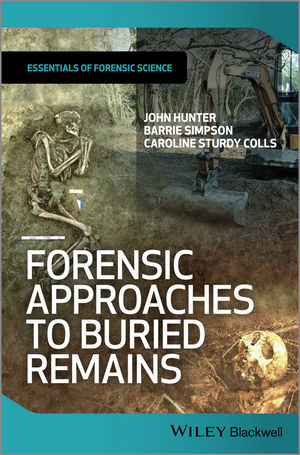
Forensic Approaches to Buried Remains
Wiley-Blackwell (Verlag)
978-0-470-66629-6 (ISBN)
The authors see this book as a reflection of the subject’s development, and as a knowledge base for the next generation of forensic archaeologists. Areas covered include:
Search logistics, integration and specialist search scenarios
Levels of confidence in site search and elimination
Urban and rural landscape reconstruction in both short and long term cases
The integration of cadaver dogs and earth-moving machinery
The recovery of multiple evidence types
Sampling strategies, spatial relevance and dating
Multiple burial scenarios
As part of the Essential Forensic Science book series this book will provide students and practitioners alike with an invaluable resource outlining both the major developments in the discipline, as well as original approaches to the search for, and recovery of buried remains.
AUTHORS John Hunter MFL (Manlove Forensics Limited), Wantage, Oxfordshire, UK and University of Birmingham, Birmingham, UK Barrie Simpson MFL (Manlove Forensics Limited), Wantage, Oxfordshire, UK Caroline Sturdy Colls MFL (Manlove Forensics Limited), Wantage, Oxfordshire, UK and Staffordshire University, Stoke-on-Trent, Staffordshire, UK
List of figures vii Series foreword xi
Preface and acknowledgements xiii
The authors xv
About the companion website xvii
1 An introduction to buried remains 1
1.1 Questions of time 1
1.2 Questions of interpretation 2
1.3 Forensic archaeology 5
1.4 Legal issues and procedures 8
1.5 Decay dynamic 10
1.6 Search methods and adaptations 12
1.7 Recovery methods and adaptation 14
1.8 Mass graves 19
2 Search theory and the landscape 23
2.1 The theory 23
2.2 Landscape mapping 30
2.3 Remote sensing 37
3 Search application 49
3.1 Geophysical survey 49
3.2 Cadaver dogs 60
3.3 Mechanical excavation 68
3.4 Bodies in aqueous environments 73
4 Search design 77
4.1 Search design 77
4.1.1 Definition of search boundaries 77
4.1.2 Recording and archiving 78
4.1.3 Thoroughness 79
4.2 Interrogating landscapes 79
4.3 Balancing probabilities 93
5 Longer-term ‘no body’ cases 101
5.1 Introduction 101
5.2 History of cold case investigation 102
5.3 Cultural changes to rural landscapes 104
5.4 Natural changes to rural landscapes 108
5.5 Planning controls and building controls 116
5.6 Current planning arrangements 118
5.7 Planning records 120
5.8 Building records 121
5.9 Special circumstances 124
5.9.1 Archaeological investigation 124
5.9.2 Listed buildings 124
5.9.3 Ecclesiastical buildings 125
5.9.4 Burial grounds 126
5.10 Landfill sites and waste disposal 131
6 Recovery, stratigraphy and destruction 137
6.1 Stratigraphy 138
6.1.1 Layers and contamination 138
6.1.2 Fire scenes 153
6.1.3 Formal exhumations 158
6.2 The destructive process 160
6.2.1 Documentation 160
6.2.2 Planning and photography 169
Appendix: The forensic archaeologist’s report (taken from Section 7 of the Standards and Guidance for Forensic Archaeologists) 178
7 Recovery, sampling and dating 181
7.1 Sieving 181
7.2 Sampling and forensic ecology 186
7.2.1 Entomology 187
7.2.2 Palynology 190
7.3 Essential taphonomics 193
7.3.1 Natural modifications 194
7.3.2 Anthropogenic modification 196
7.4 Physical anthropology, recovery and surface scatters 199
7.5 Dating 204
7.5.1 Relative dating 206
7.5.2 Absolute dating 208
8 The investigation of multiple burials 213
8.1 Diversity and challenges 213
8.2 Developments 218
8.3 Interrogating the evidence 221
8.4 The aftermath of conflict 225
8.5 Politics and Religion 227
8.6 Archives for history 228
Bibliography 233
Index 251
| Erscheint lt. Verlag | 1.11.2013 |
|---|---|
| Reihe/Serie | Essential Forensic Science |
| Verlagsort | Hoboken |
| Sprache | englisch |
| Maße | 170 x 244 mm |
| Gewicht | 463 g |
| Themenwelt | Naturwissenschaften ► Biologie |
| Naturwissenschaften ► Geowissenschaften ► Geologie | |
| Recht / Steuern ► Strafrecht ► Kriminologie | |
| ISBN-10 | 0-470-66629-3 / 0470666293 |
| ISBN-13 | 978-0-470-66629-6 / 9780470666296 |
| Zustand | Neuware |
| Haben Sie eine Frage zum Produkt? |
aus dem Bereich


